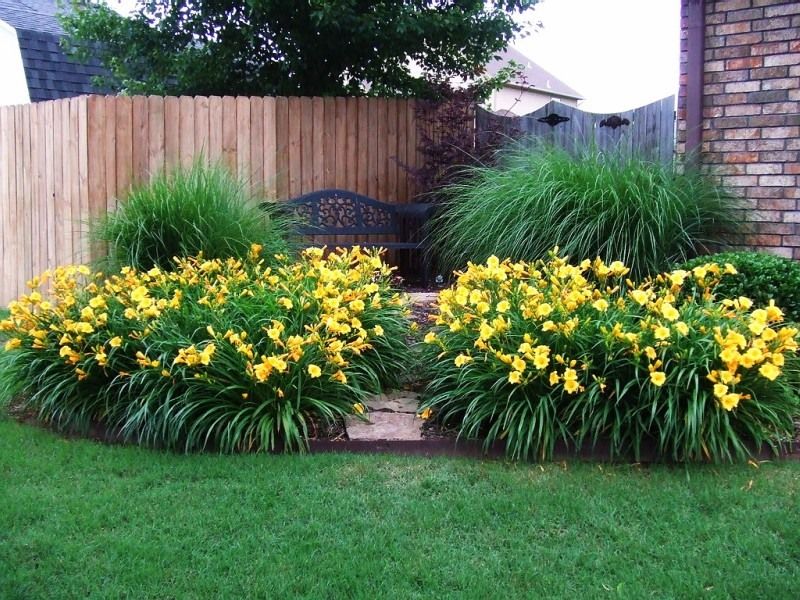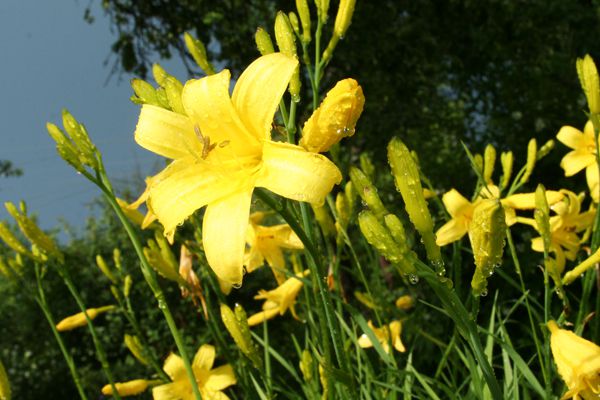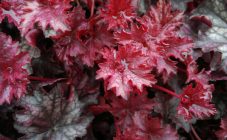Content:
Experienced gardeners, when landscaping a summer cottage, always draw up a plan taking into account the natural conditions and draw up it in accordance with the basic principles of landscape design - they plan the unity of the composition, take care of simplicity and colors - they work on creating a place for relaxation in the garden. There are also small landscape tricks using daylilies in the garden - famous designers repeat the design elements - three or five times.
Daylilies in the landscape are widely used in the arrangement of country estates, dachas and parks. Low-growing hybrids adorn the borders of flower beds, next to hosts and cereals. Daylilies in garden design with a height of 30 cm or more are planted in groups in the background of mixborders, or in wide rows along walls and fences. In this way, paths and alleys in parks and gardens are often lined.
Planning and planting in the garden. What to plant next to daylilies
Beautiful elongated leaves, double or miniature flowers - in all their diversity, daylilies are combined with the large number of plants in the flower bed with which they are planted. Planting begins in the spring, when there is no excess moisture in the soil. Some varieties tolerate shade or proximity to water, but in general, daylilies prefer slightly acidic soil with moderate watering, and sunny areas. On alpine slides, in pots, the composition of the earth is thought out in advance, fertilizers are fed on such poor soils several times over the summer.
They often approach the design of a mixboard with perennials creatively and successively planted Krasnodnyi on a flower bed (this is another name for daylilies) - from low to high. This creates a smooth transition in height to the trees. Or a composition is made from lilac to light pink, yellow to orange - the design of such a flower bed with daylilies is called a collection design.
What shrubs best coexist with a large daylily?
Tall specimens look against the background of ornamental shrubs - barberry, deren, or coniferous trees - thuja, juniper, blue spruce. Medium-high daylilies of delicate shades are planted next to rose bushes, the neighborhood of varieties is selected according to the matching shades and flowering time.
Lemon perennials are planted in the background of mixborders. Particular attention is paid to the color scheme.
A perfect addition to a light yellow flower garden will be silvery cereals or flowers of blue and purple shades. Daylilies with yellow-orange tones are also planted along brick walls - flowers only benefit from dark facades in the background. Hybrids of dark, burgundy, lilac, purple shades are better suited to light facades of buildings.What else daylilies are combined with in this color scheme are phlox and astilbe, lilies.
Care
Daylilies are rarely susceptible to diseases, more often unfavorable conditions become the cause of the disease - stagnant moisture, scarcity of soil or root damage by insects. The affected plants are dug up, treated with an insecticide or potassium permanganate solution, and transplanted.
Otherwise, caring for these flowers is simple - for a healthy look, daylilies in the garden are fed in the spring, transplanted at the end of summer every 5 or 7 years, in late autumn the leaves are cut off. Daylilies reproduce by dividing the bush, cuttings, and occasionally by seeds.
The proximity of daylilies with other flowers can be of significant benefit. The old leaves of tulips and daffodils are hidden behind the healthy green foliage of krasodnev before pruning, the yellowish arrows of decorative bows are hidden, and the fence is decorated. They bloom at different times of the day, some varieties bloom at night. When buying, be sure to check the ability to grow a flower in your strip and the main species characteristics by name. Daylilies in landscape design are a real find for a beginner and an experienced gardener.
Daylilies are widespread in Japan and China; in these Asian countries, flowers are not only placed in a vase, but dishes are prepared with them.
With a carefully thought out planting site, daylilies can perfectly decorate a garden plot or a park area.














